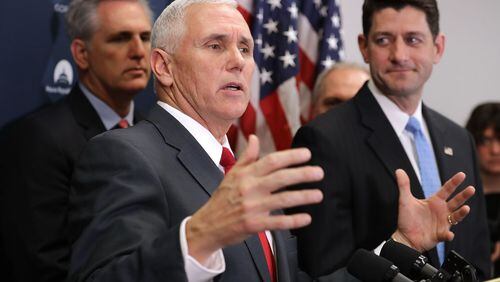As part of his visit to Capitol Hill to kick off Republican efforts to repeal the Affordable Care Act, Vice President-elect Mike Pence blasted the law — also known as Obamacare — for its impact on ordinary Americans’ finances.
“Right now, the American people are laboring under extraordinary increases in premiums,” Pence told reporters. “The average deductible for a bronze policy (the least comprehensive Obamacare offering) today is $12,000. American families have seen an increase in premiums of $5,000. And this year, the average premium increase on families has been over 25 percent, and 100 percent in some American states. That all comes to an end when we set in motion an effort to repeal and replace Obamacare.”
Pence was right that the premiums for policies purchased on the online marketplace HealthCare.gov were slated to be 25 percent higher in 2017 than 2016. When the Department of Health and Human Services announced that figure, it became a major talking point for Republicans like presidential candidate Donald Trump.
But the part of Pence’s comment that raised our eyebrows was that under Obamacare, “American families have seen an increase in premiums of $5,000.”
As we discovered, that’s not really correct. The Trump-Pence transition office did not respond to our inquiries.
How much did premiums rise for Obamacare policies?
We started by looking at the data released by HHS about average Obamacare premiums. This data has been released for four years — 2014 to 2017. We looked at one of the standard measurements the department calculates every year — what a family of four with a household income of $60,000 would pay for premiums on the second-lowest-cost silver plan. (As you might guess, a silver plan is more comprehensive than a bronze plan, but less generous than gold and platinum plans.)
Premiums for this type of policy started at $9,468 a year in 2014, rose very modestly to $9,636 in 2015, rose somewhat more aggressively to $10,428 in 2016, and then rather substantially — 25 percent — to $13,080 in 2017.
Altogether, then, average premiums for this type of Obamacare plan rose by a cumulative 38 percent during that period, which is not a trivial amount. However, the raw dollar increase was less than what Pence said — $3,612 rather than $5,000.
So Pence’s dollar figure is exaggerated.
That said, we’ll note a few additional bits of context, some helpful to Pence’s overall argument and some not.
• Consumers won’t be paying all of this amount. This $3,612 figure doesn’t take into account the subsidies that most marketplace purchasers qualify for. Once the average level of subsidies are included in the calculation, the actual out-of-pocket premium cost borne by qualifying consumers actually decreased slightly between 2014 and 2017 — a drop of $60, from $4,920 in 2014 to $4,860 in 2017. That’s an important piece of context that’s missing from Pence’s comment.
• Premiums on HealthCare.gov have risen faster than premiums for employer-sponsored plans. We looked at data calculated annually by the Kaiser Family Foundation and the Health Research and Educational Trust about employer-provided policies and their premiums.
Between 2013 and 2016, premiums for the average full-family, employee-sponsored plan rose by a cumulative 11 percent. That’s well below the increase for Obamacare plans, which as we noted was 38 percent between 2014 and 2017.
• Before Obamacare, under President George W. Bush, overall premium increases were faster. Before you assume that all premiums rose faster under Obama, consider this. According to the Kaiser/Health Research and Educational Trust studies, family premiums for employer-sponsored insurance increased by a cumulative 99 percent — basically doubling — under the eight years of Bush, while under eight years of Obama, they rose by a much more modest 59 percent. On this score, the news is not great for Pence.
Our ruling
Pence said that under Obamacare, “American families have seen an increase in premiums of $5,000.”
Judged in context, Pence appears to be talking only about people who buy their insurance from HealthCare.gov. And in reality, the increase for the most common yardstick plan from HealthCare.gov has been smaller than that — $3,612. Over the same time period, federal subsidies actually decreased what the average marketplace purchaser had to pay.
On the other hand, $3,612 is not a trivial increase, and it’s valid to note that the premiums rose significantly faster for these plans than they did for employer-sponsored insurance over an equivalent period.
We rate Pence’s statement Half True.
Under Obamacare, “American families have seen an increase in premiums of $5,000.”
— Mike Pence on Wednesday, January 4th, 2017 in comments to reporters on Capitol Hill







